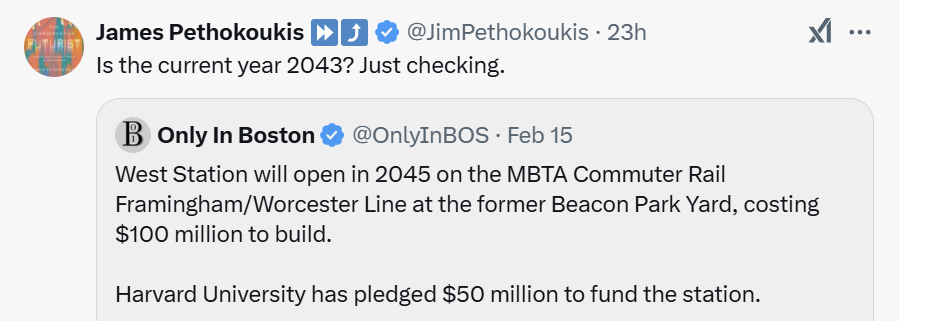⤴ The Formula for the Future
Here's what will create a Golden Path to an Up Wing future for America and the world
My fellow pro-growth Up Wingers,
The latest US moonshot comes with earthly hurdles. I mean, of course it does.
The Stargate project — a purported (as much as) $500 billion private-sector initiative to build artificial intelligence infrastructure — exemplifies both America's vast technological ambitions and its deep regulatory morass. Thanks to America's Byzantine permitting regime, Stargate faces a thicket of environmental reviews and land-use restrictions that have long bedeviled the country's infrastructure dreams — even modest ones like building a subway station.
When I recently asked energy regulation expert James Coleman whether Stargate, the Green Economy, the Nuclear Economy, continental high-speed rail, or whatever your favorite mega-project happens to be could be build without regulatory reform, his plain answer: “No, it won't happen.”
A golden path
But let's take a step back. Stargate embodies a powerful and propulsive Up Wing formula for societal progress: Information processing power + energy abundance + entrepreneurial techno-capitalism.
It's the Formula for the Future, as I see it.
That pro-growth trinity of abundance represents America's best shot at 21st-century superpower dominance — one might even call it a “New Golden Age.” Indeed that trinity represents the key elements of a “Golden Path,” to use a concept concept from Dune, which offers humanity a way forward through existential challenges. Like the Golden Path of Frank Herbert's imagination, this grouping promises both transformation and tribulation. Unlike that fictional version, however, our journey forward doesn't require prophetic powers — just the will to overcome bureaucratic inertia and the courage to embrace technological progress even with all its inherent disruption.
So: Can America transcend a half-century of regulatory paralysis to seize this golden opportunity? History suggests doing so is a must. There is no alternative.
⏩ First, as I wrote last year (a must-read issue of this newsletter), societies evolve through their collective ability to process information. While our hunter-gatherer ancestors possessed the same cognitive hardware we do, they lacked the force-multiplier of millions of specialized educated workers, globally interconnected info-industrial economic systems, and advanced technologies. A project like Stargate isn't a mere infrastructure play — it represents a civilization-scale upgrade to humanity's computational capabilities.
⏩ Second, the relationship between energy and progress has always been symbiotic—from Britain's coal-fired Industrial Revolution to America's petroleum-powered 20th century. Today's AI systems devour electricity with the appetite of small cities. Tomorrow's challenges — from carbon capture to desalinization to space colonization — will demand even more. The solution isn't energy austerity but abundance through innovation: advanced nuclear, deep geothermal, next-generation solar, and whatever else America's smarties can conjure up.
⏩ Third, the secret sauce remains economic freedom. Adam Smith's invisible hand proves remarkably adept in the Information Revolution as in the Industrial Revolution. And America's market-driven innovation ecosystem — when combined with a liberal society and government able to supply public goods like basic science research — still leads in creating world-changing technologies. The reason? Economic freedom creates the fertile chaos from which breakthrough innovations emerge. Let’s never forget it.
🔁 Finally, the aforementioned elements create a virtuous cycle of Up Wing progess. More computation enables better energy systems and optimizes markets. Abundant energy powers more advanced computing and fuels economic growth. Economic freedom drives innovation across the board. It's this pro-growth feedback loop that forms the core of the Formula for the Future.
Regulatory roadblocks
But here's the catch: these virtuous cycles and feedback loops are continually disrupted by regulatory barriers. The precautionary principle — better safe than sorry — has morphed from prudent guidance into innovation-killing bureaucracy. Environmental reviews take longer than the Manhattan Project. AI safety concerns, while legitimate, risk becoming a convenient excuse for technological retreat. The solution isn't to abandon oversight but to embrace what some call the proactionary principle: to take no risk may be the greatest risk of all.
Herman Kahn, the nuclear war theories turned sunny futurist who plays a key role in my 2023 book, understood this dynamic decades ago. While others in the “limits to growth” 1970s fixated on potential catastrophes such as overpopulation and resource exhaustion — even a possible Ice Age — Kahn focused on humanity's potential for progress via risk-taking techno-capitalism.
The challenges in the 2020s may be different, but the principle remains: Societies that lose their nerve lose their edge. They can longer push forward the technological frontier. A fantastic future of greater prosperity and abundance will need ever-increasing computational power to intelligently innovate it, more energy to power it, and more economic freedom to adapt it.
The stakes are incredible. They transcend mere domestic prosperity: Will humanity pioneer a model of abundance that extends across the planet and then across Solar System?
The Formula for the Future beckons.
On sale everywhere ⏩ The Conservative Futurist: How To Create the Sci-Fi World We Were Promised






